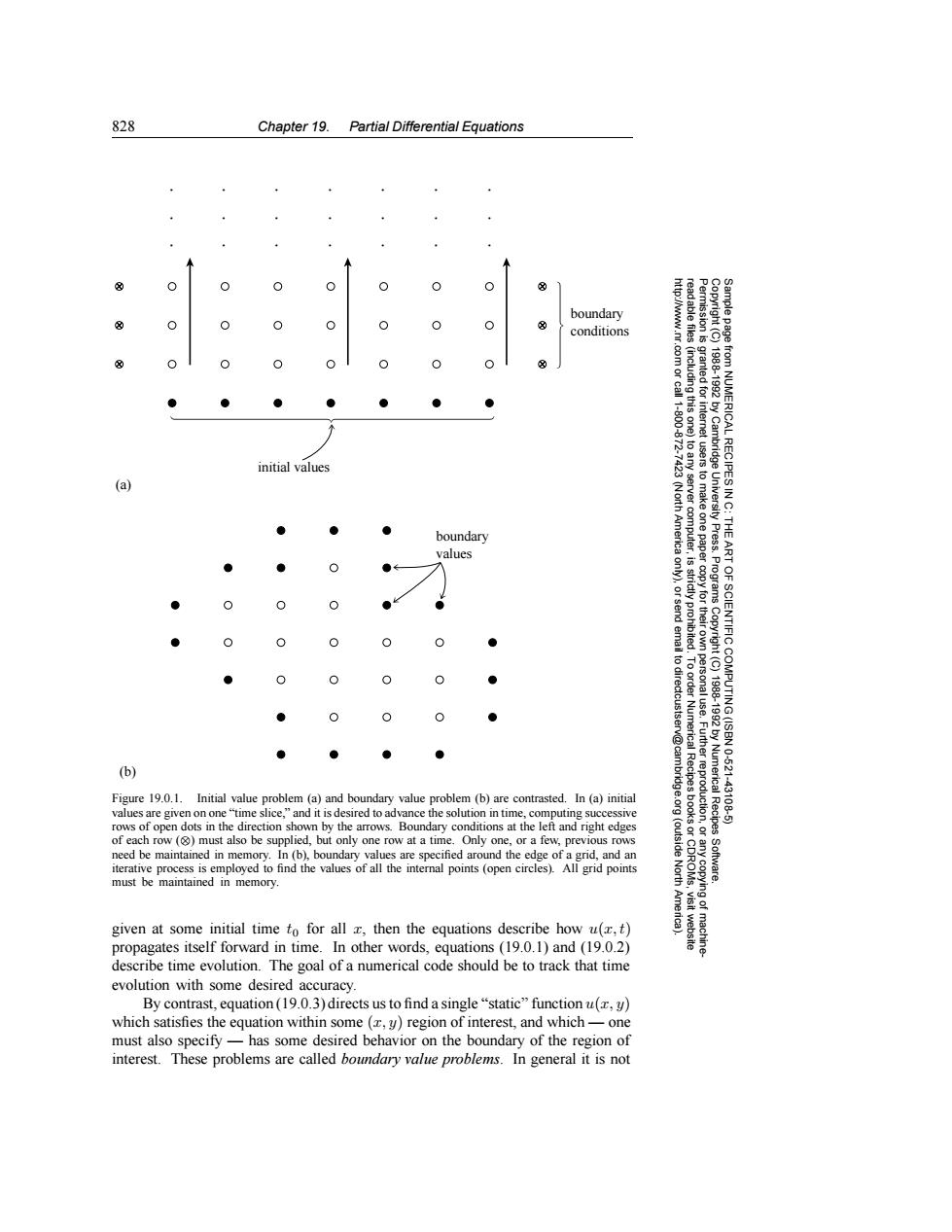正在加载图片...

828 Chapter 19. Partial Differential Equations boundary conditions http://www.nr. ● 83 (including this one) granted for i 11-800-872 initial values (a) ● boundary 7423 (North America to any server computer,is strictly prohibited. users to make one paper 1988-1992 by Cambridge University Press.Programs Copyright(C) from NUMERICAL RECIPES IN C: THE values ● only),or ● copy for their ● ● ● ● email to directcustsen ● ● (b) v@cambr 1988-1992 by Numerical Recipes ART OF SCIENTIFIC COMPUTING (ISBN 0-521-43108-5) Figure 19.0.1.Initial value problem (a)and boundary value problem(b)are contrasted.In (a)initial values are given on one "time slice,"and it is desired to advance the solution in time,computing successive rows of open dots in the direction shown by the arrows.Boundary conditions at the left and right edges of each row (must also be supplied,but only one row at a time.Only one,or a few,previous rows (outside need be maintained in memory.In (b),boundary values are specified around the edge of a grid,and an iterative process is employed to find the values of all the internal points (open circles).All grid points must be maintained in memory. North Software. given at some initial time to for all z,then the equations describe how u(x,t) visit website propagates itself forward in time.In other words,equations(19.0.1)and(19.0.2) machine describe time evolution.The goal of a numerical code should be to track that time evolution with some desired accuracy. By contrast,equation(19.0.3)directs us to find a single"static"functionu(,y) which satisfies the equation within some(z,y)region of interest,and which-one must also specify-has some desired behavior on the boundary of the region of interest.These problems are called boundary value problems.In general it is not828 Chapter 19. Partial Differential Equations Permission is granted for internet users to make one paper copy for their own personal use. Further reproduction, or any copyin Copyright (C) 1988-1992 by Cambridge University Press. Programs Copyright (C) 1988-1992 by Numerical Recipes Software. Sample page from NUMERICAL RECIPES IN C: THE ART OF SCIENTIFIC COMPUTING (ISBN 0-521-43108-5) g of machinereadable files (including this one) to any server computer, is strictly prohibited. To order Numerical Recipes books or CDROMs, visit website http://www.nr.com or call 1-800-872-7423 (North America only), or send email to directcustserv@cambridge.org (outside North America). . . . . . . . . . . . . . . . . . . . . . boundary conditions initial values (a) boundary values (b) Figure 19.0.1. Initial value problem (a) and boundary value problem (b) are contrasted. In (a) initial values are given on one “time slice,” and it is desired to advance the solution in time, computing successive rows of open dots in the direction shown by the arrows. Boundary conditions at the left and right edges of each row (⊗) must also be supplied, but only one row at a time. Only one, or a few, previous rows need be maintained in memory. In (b), boundary values are specified around the edge of a grid, and an iterative process is employed to find the values of all the internal points (open circles). All grid points must be maintained in memory. given at some initial time t0 for all x, then the equations describe how u(x, t) propagates itself forward in time. In other words, equations (19.0.1) and (19.0.2) describe time evolution. The goal of a numerical code should be to track that time evolution with some desired accuracy. By contrast, equation (19.0.3) directs us to find a single “static” function u(x, y) which satisfies the equation within some (x, y) region of interest, and which — one must also specify — has some desired behavior on the boundary of the region of interest. These problems are called boundary value problems. In general it is not